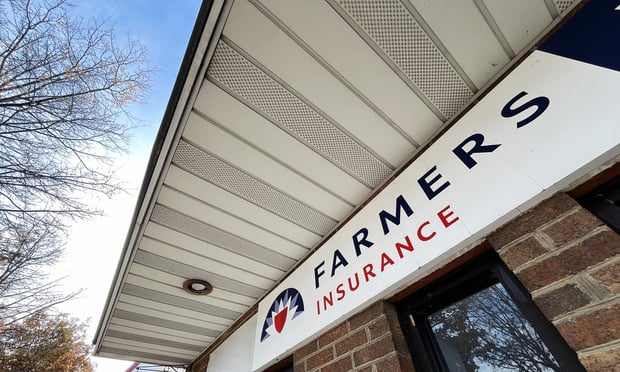As the Northeast begins digging out from Winter Storm Niko, those of us sitting inside our homes and offices, safe and warm, are thinking about those who have to be at work, regardless of the weather.
For example, firefighters, police officers, medical personnel, utility company personnel and snow removal employees have no choice but to face the hazards of winter weather.
And as the clean-up after the storm begins, employees in other industries will be dealing with severe weather conditions to get their businesses back in operation.
In addition to cold stress, the Occupational Safety and Health Administration (OSHA) reminds us, there are other winter weather-related hazards that workers may be exposed to when performing tasks such as driving in the snow, removing snow from rooftops, and working near downed or damaged power lines.
If you're in one of the top states for claims related to freezing temperatures, you know that clearing roads and rooftops promptly is the key to minimizing damage to property and preventing injuries.
Here are some tips from OSHA for employers on keeping employees safe when they're facing these winter weather hazards:
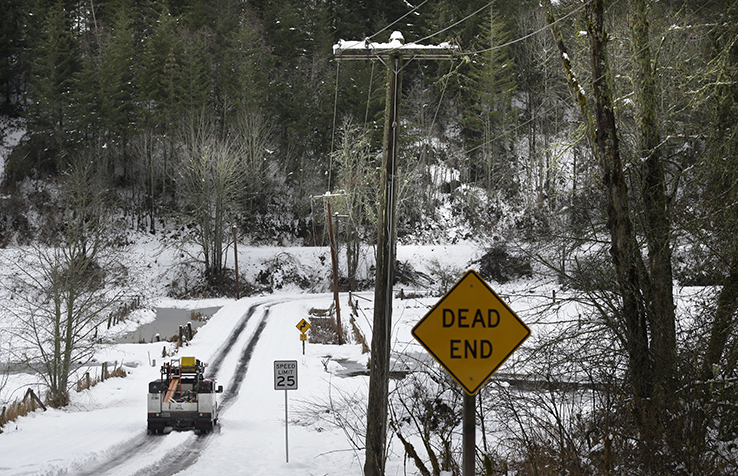
A Potelco Inc. truck doing work for Puget Sound Energy drives down a rural road to work on a power outage in a remote area near Eatonville, Wash., Tuesday, Feb. 7, 2017. (AP Photo/Ted S. Warren)
|1. Winter driving
Although employers can't control roadway conditions, they can promote safe driving behavior by ensuring that their workers:
- Recognize the hazards of winter weather driving, for example, driving on snow- or ice-covered roads;
- Are properly trained for driving in winter weather conditions; and
- Are licensed (as applicable) for the vehicles they operate.
Employers should set and enforce driver safety policies. Employers should also implement an effective maintenance program for all vehicles and mechanized equipment that workers are required to operate.
Employers should ensure properly trained workers inspect the vehicle systems, such as brakes, tires and the exhaust system, to determine whether they're working properly, and make immediate repairs if they aren't.
Workers who have to be out in winter weather, especially in storms, should all carry emergency kits that include the following:
- Cellphone or two-way radio.
- Windshield ice scraper, snow brush and shovel.
- Flashlight with extra batteries.
- Tow chain.
- Traction aids (bag of sand or cat litter).
- Emergency flares and a first-aid kit.
- Jumper cables.
- Snacks and water.
- Road maps.
- Blankets and a change of clothes.

Traffic navigates a construction zone in Saratoga Spring, N.Y., on Thursday, Jan. 26, 2012. (AP Photo/Mike Groll)
|2. Work zone traffic safety
Workers being struck by vehicles or mobile equipment lead to many work zone fatalities or injuries annually. Drivers may skid, or lose control of their vehicles more easily when driving on snowy or icy roads, or in a storm with significantly reduced visibility.
Related: 10 states with the worst drivers
Employers must ensure that work zones are correctly set up with the traffic controls identified by signs, cones, barrels and barriers, to protect workers.
Workers exposed to vehicular traffic should wear the appropriate high visibility vest at all times, so that they can be easily seen by motorists.

Soldiers with the 275th Military Police company, and a Washington Firefighter, in a Humvee, assist a stranded motorist in the snow on I-395, Jan. 23, 2016 in Washington. (AP Photo/Alex Brandon)
|3. Stranded in a vehicle
Employers should train employees on what to do if they're stranded in a vehicle.
- Stay in the vehicle. Call for emergency assistance if needed, recognizing that response time may be slow in severe winter weather conditions.
- Notify your supervisor of your situation. Don't leave the vehicle to search for assistance unless help is visible within 100 yards. You may become disoriented and get lost in blowing and drifting snow.
- Display a trouble sign by hanging a brightly colored cloth on the vehicle's radio antenna and raising the hood.
- Turn on the vehicle's engine for about 10 minutes each hour and run the heat to keep warm. Also, turn on the vehicle's dome light when the vehicle is running as an additional signal. Beware of carbon monoxide poisoning. Keep the exhaust pipe clear of snow, and open a downwind window slightly for ventilation.
- Watch for signs of frostbite and hypothermia. Do minor exercises to maintain good blood circulation in your body. Clap your hands and move your arms and legs occasionally. Try not to stay in one position for too long. Stay awake, you will be less vulnerable to cold-related health problems. Use blankets, newspapers, maps and even the removable car mats for added insulation.
- Avoid overexertion since cold weather puts an added strain on the heart. Unaccustomed exercise such as shoveling snow or pushing a vehicle can bring on a heart attack or make other medical conditions worse.
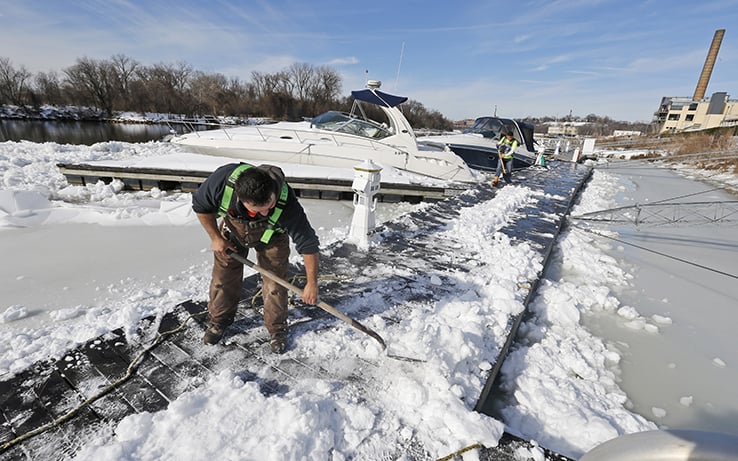
Jose Rodriguez shovels snow off a dock on the ice-choked James river near downtown Richmond, Va., Monday, Jan. 25, 2016. (AP Photo/Steve Helber)
|4. Shoveling snow
Shoveling snow can be a strenuous activity, particularly because cold weather can be taxing on the body. There is a potential for exhaustion, dehydration, back injuries or heart attacks.
During snow removal in addition to following the tips for avoiding cold stress, such as taking frequent breaks in warm areas, there are other precautions workers can take to avoid injuries.
Workers should warm-up before the activity, scoop small amounts of snow at a time and where possible, push the snow instead of lifting it. The use of proper lifting technique is necessary to avoid back and other injuries when shoveling snow:
- Keep the back straight,
- Lift with the legs, and
- Don't turn or twist the body.
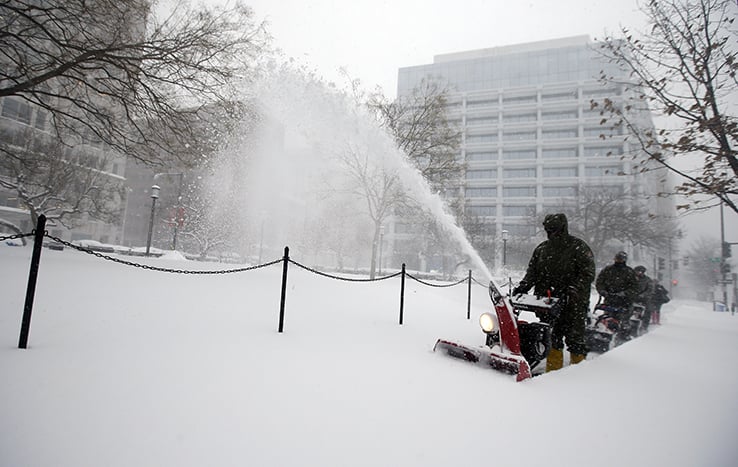
U.S. Park Service employees use snow blowers to clear the sidewalk of Edward R. Murrow park, Saturday, Jan. 23, 2016 in Washington. (AP Photo/Alex Brandon)
|5. Using snow removal equipment
It's important to make sure that powered equipment, such as snow blowers, are properly grounded to protect workers from electric shocks or electrocutions. When performing maintenance or cleaning, make sure the equipment is properly guarded and is disconnected from power sources.
Snow blowers commonly cause lacerations or amputations when operators attempt to clear jams with the equipment turned on. Train workers to never attempt to clear a jam by hand.
- Turn the snow blower off and wait for all moving parts to stop.
- Use a long stick to clear wet snow or debris from the machine.
- Keep your hands and feet away from moving parts.
Workers should refuel a snow blower before starting the machine and never add fuel when the equipment is running or when the engine is hot.

Workers clear snow from a roof in Boston, Monday, Feb. 16, 2015. (AP Photo/Michael Dwyer)
|6. Clearing snow from roofs and working at heights
Employers must evaluate snow removal tasks for hazards and plan how to do the work safely. Workers should be aware of the potential for unexpected hazards due to the weather conditions, for example, layers of ice can form as the temperature drops, making surfaces even more slippery. A surface that's weighed down by snow must be inspected by a competent person to determine whether it's structurally safe for workers to access it, because it may be at risk of collapsing.
Snow-covered rooftops can hide hazards such as skylights that workers can fall through. overhead power lines or snow removal equipment can also cause electrical hazards.
Employers can protect workers from these hazardous work conditions, for example, by using snow-removal methods that don't involve workers going on roofs, when and where possible. Employers should determine the right type of equipment, such as ladders or aerial lifts, and personal protective equipment (PPE), such as personal fall arrest systems, for the job and ensure that workers are trained on how to properly use them.
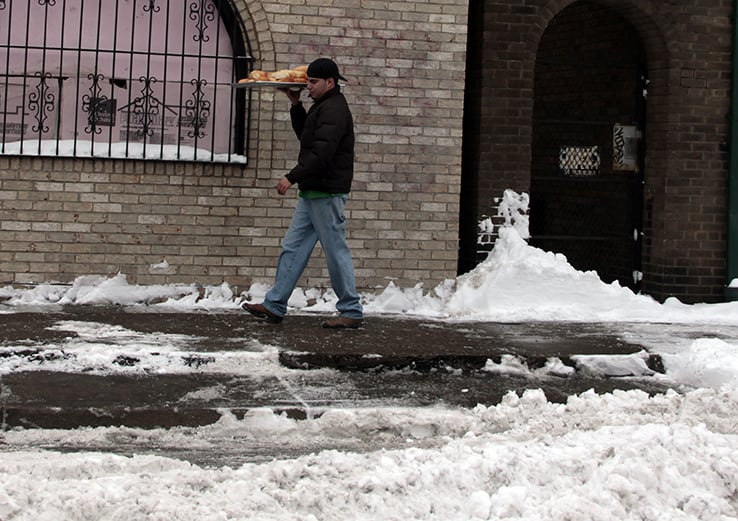
Alberto Chavez of Detroit, treads lightly on slippery sidewalks while making a bread delivery to a local supermarket on Feb. 21, 2011 in Detroit. (AP Photo/Jerry S. Mendoza)
|7. Preventing slips on snow and ice
To prevent slips, trips and falls, employers should clear walking surfaces of snow and ice, and spread de-icer, as quickly as possible after a winter storm. In addition, the following precautions will help reduce the likelihood of injuries:
- Require employees to wear proper footwear when walking on snow or ice is unavoidable, because it is especially treacherous. A pair of insulated and water resistant boots with good rubber treads is a must for walking during or after a winter storm.
- Suggest that employees keep a pair of rubber over-shoes with good treads that fit over street shoes at the workplace during the winter months.
- Remind employees to take short steps and walk at a slower pace so they can react quickly to a change in traction, for example, when walking on an icy or snow-covered walkway.
Related: Here are the top 10 most costly U.S. workplace injuries
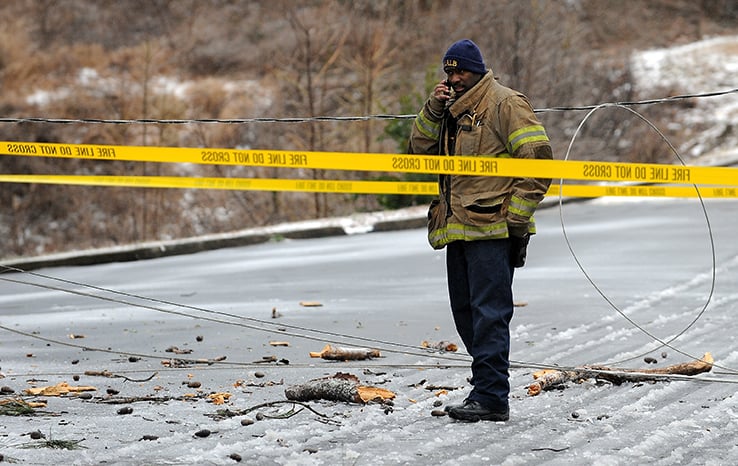
DeKalb County fire department Capt. Kevin James secures a downed power line that disrupted electricity to 200 residents at the Marquis at Lenox apartments when freezing rain, sleet and snow brought down a tree that crashed into transformer and damaged several vehicles during a winter storm on Feb. 12, 2014, in Atlanta. (AP Photo/David Tulis)
|8. Repairing downed or damaged power lines
A common problem during a blizzard or other winter storm can be a power outage. Repairing or replacing damaged power lines in severe winter weather conditions is especially hazardous to workers. The moisture in snow can reduce the insulation value of protective equipment and could cause electrocution. In these conditions de-energized work is safer, but if energized work must be done, qualified workers and supervisors must first conduct a hazard analysis that includes evaluating the weather conditions and identifying how to safely do the job.
Other potential hazards include:
- Electrocution by touching downed energized power lines or objects, such as broken tree limbs, in contact with downed energized power lines,
- Fires caused by an energized line or equipment failure, and
- Being struck or crushed by falling tree limbs or collapsing utility poles.
When working on downed or damaged power lines, electrical utility workers should use safe work practices, as well as appropriate tools and equipment (including PPE).
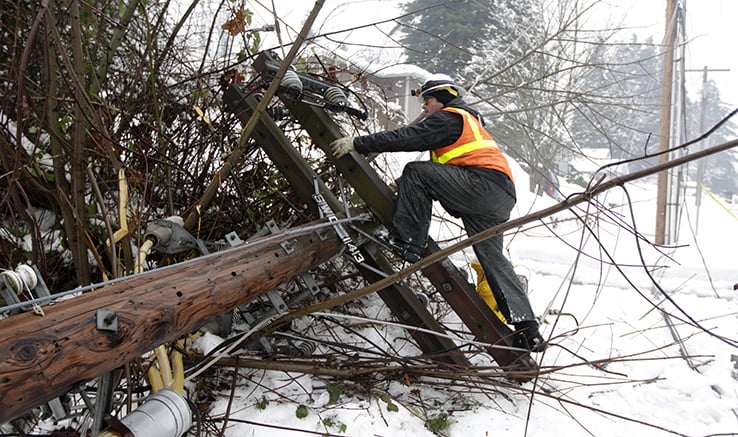
Derrick Lonneker climbs up a downed power pole, as he works to repair a transmission line damaged by a falling tree near a substation, Jan. 20, 2012, in Olympia, Wash. (AP Photo/Ted S. Warren)
|9. Working near downed or damaged power lines
As employees clear parking lots and sidewalks, or return to working on construction projects, for example, they might encounter downed power lines.
Employers should train workers to assume that all power lines are energized and stay clear of any that have been knocked down or damaged by winter weather, which could include a storm or icicles hanging from the lines.
When workers find downed or damaged power lines, they should establish a safe zone, some distance away from power lines and report any incidents to the responsible authority. Only properly trained electrical utility workers can handle damaged power lines.
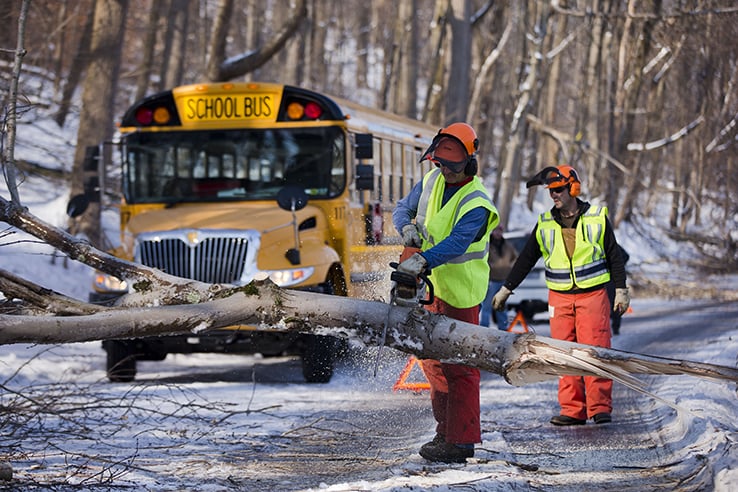
Workmen clear a downed tree blocking a school bus in the aftermath of a winter storm, Friday, Feb. 7, 2014, in Downingtown, Pa. (AP Photo/Matt Rourke)
|10. Removing downed trees
Clearing downed trees is a critical job during severe winter weather conditions, and the job often falls to emergency crews to remove any trees that block public roads and damage power lines.
- Potential hazards include:
- Electrocution by contacting downed energized power lines or contacting broken tree limbs in contact with downed energized power lines,
- Falls from heights, or
- Being injured by equipment such as chain saws and wood chippers.
Workers should wear PPE that protects them from the hazards of the tree removal tasks. Workers using chainsaws and chippers to clear downed trees should use gloves, chaps, foot protection, eye protection, fall protection, hearing protection and head protection.
Only powered equipment designed for outdoor and wet conditions should be used. Use all equipment and tools (such as saws and chippers) properly and for the purpose that they are designed for.
Ensure that equipment is always maintained in serviceable condition and inspected before use by a knowledgeable person who can identify any problems with the equipment. Don't use equipment that is not functioning properly.
Equipment must have proper guarding; safe guards must never be bypassed. All controls and safety features must function as designed by the manufacturer.
Want to continue reading?
Become a Free PropertyCasualty360 Digital Reader
Your access to unlimited PropertyCasualty360 content isn’t changing.
Once you are an ALM digital member, you’ll receive:
- Breaking insurance news and analysis, on-site and via our newsletters and custom alerts
- Weekly Insurance Speak podcast featuring exclusive interviews with industry leaders
- Educational webcasts, white papers, and ebooks from industry thought leaders
- Critical converage of the employee benefits and financial advisory markets on our other ALM sites, BenefitsPRO and ThinkAdvisor
Already have an account? Sign In Now
© 2024 ALM Global, LLC, All Rights Reserved. Request academic re-use from www.copyright.com. All other uses, submit a request to [email protected]. For more information visit Asset & Logo Licensing.



